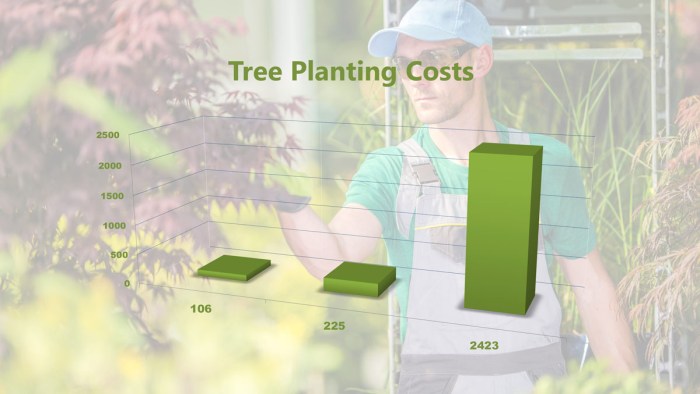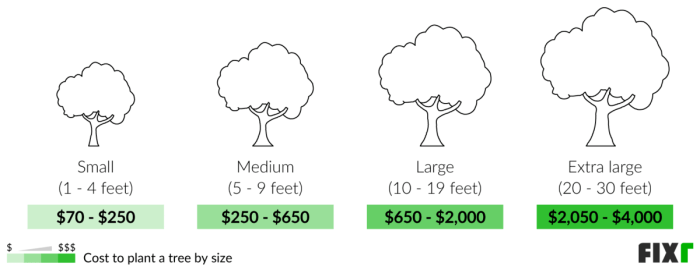Factors Influencing Tree Planting Costs

Price to plant a tree – Planting a tree, while seemingly simple, involves a complex interplay of factors that significantly impact the final cost. Understanding these variables is crucial for both homeowners embarking on landscaping projects and larger-scale reforestation initiatives. This knowledge empowers informed decision-making, ensuring both budgetary responsibility and ecological success.
The cost to plant a tree varies greatly depending on species and location. For example, if you’re interested in contributing to a meaningful cause, you might consider the price involved in supporting a project like plant an olive tree palestine , where the costs likely include sapling acquisition, planting, and ongoing care. Ultimately, the price to plant a tree, whether it’s an olive tree or another variety, reflects the resources and effort required.
Tree Species, Size, and Location
The cost of planting a tree is highly dependent on the species chosen, its size, and the location where it will be planted. Different species have varying growth rates, root systems, and susceptibility to disease, influencing the labor and materials required. Larger trees, naturally, demand more resources and expertise for planting, leading to a higher cost. Location plays a critical role; accessibility to the planting site, soil conditions, and existing infrastructure can all influence the time and equipment needed, impacting the overall expense.
| Factor | Description | Cost Impact | Example |
|---|---|---|---|
| Tree Species | Different species have varying planting requirements. Some are more delicate and require specialized care. | High variability; rare or difficult-to-transplant species command higher prices. | Planting a Redwood will cost significantly more than planting a common maple. |
| Tree Size | Larger trees require more labor, equipment, and potentially specialized techniques for successful transplanting. | Directly proportional; larger trees = higher costs. | A 15-foot oak will be much more expensive to plant than a 2-foot sapling. |
| Location | Accessibility, soil conditions, and existing landscaping can significantly influence labor and equipment needs. | High variability; difficult-to-access locations increase costs. | Planting a tree on a steep hillside will be more expensive than planting one in a flat, accessible yard. |
| Labor Costs | The cost of labor varies depending on location, expertise required, and the scale of the project. | Significant; labor represents a large portion of the overall cost. | Urban areas tend to have higher labor costs than rural areas. |
| Soil Conditions | Poor soil may require soil amendment, potentially adding to the overall cost. | Variable; significant costs may be incurred for soil remediation. | Rocky or clay soil may require extensive preparation before planting, increasing the cost. |
Seedlings versus Mature Trees: A Cost Comparison, Price to plant a tree
The decision between planting seedlings or mature trees involves a trade-off between immediate visual impact and long-term growth potential. Each option presents distinct advantages and disadvantages that significantly affect cost.
Understanding the pros and cons is vital for making an informed decision aligned with your budget and long-term goals.
- Seedlings:
- Pros: Lower initial cost, faster establishment in ideal conditions, wider selection of species.
- Cons: Higher mortality rate, slower initial growth, require more time and attention to reach maturity, vulnerable to pests and diseases.
- Mature Trees:
- Pros: Immediate aesthetic impact, faster shade provision, established root system, higher survival rate.
- Cons: Higher initial cost, more labor-intensive planting, higher transportation costs, potential for transplant shock.
Hypothetical Cost Scenario
Consider planting a 15-foot Japanese Maple in a difficult-to-access area with rocky soil. This scenario combines several high-cost factors: the species itself is relatively expensive, the size requires specialized equipment and expertise, the location necessitates additional labor and potentially specialized transportation, and the soil conditions necessitate soil amendment. The total cost could easily be several times higher than planting a smaller, common tree in a readily accessible location with well-drained soil.
For instance, planting a small maple sapling in a prepared garden bed might cost $50-$100, while the described scenario could easily reach $1000 or more.
Geographic Variations in Tree Planting Prices: Price To Plant A Tree
The cost of planting a tree isn’t uniform across the globe. It’s a dynamic figure, intricately woven into the fabric of geography, reflecting the unique challenges and opportunities presented by diverse environments. Let’s delve into the fascinating interplay between location and the price tag on planting a tree.
Numerous factors, working in concert, determine the final cost. Climate, soil conditions, accessibility, labor costs, and even regional regulations all play their part. Understanding these influences is crucial for anyone involved in large-scale tree planting initiatives or even individual landscaping projects.
Regional Price Variations in Tree Planting
The following table illustrates how tree planting costs can vary significantly across different regions, highlighting the impact of geographical factors. These figures are estimates and can fluctuate based on specific project details.
| Region | Climate | Soil Conditions | Estimated Cost per Tree (USD) |
|---|---|---|---|
| Arid Southwest (USA) | Hot, dry, infrequent rainfall | Sandy, rocky, often poor drainage | $25 – $75 |
| Pacific Northwest (USA) | Temperate, rainy, fertile soil | Rich, well-drained, volcanic soil in some areas | $15 – $40 |
| Canadian Prairies | Continental, cold winters, hot summers | Varied, often fertile but susceptible to drought | $20 – $60 |
| Mediterranean Europe | Hot, dry summers, mild, wet winters | Varied, often rocky and dry | $30 – $80 |
Impact of Regional Regulations and Permits
Regional regulations significantly influence tree planting costs. Understanding and navigating these requirements is paramount.
The importance of compliance with local regulations cannot be overstated. Failure to do so can lead to delays, penalties, and ultimately, increased costs.
- Permitting fees: Obtaining necessary permits for tree planting can vary greatly depending on the location and the scale of the project. Some regions may have streamlined processes, while others may require extensive documentation and review.
- Environmental impact assessments: In environmentally sensitive areas, comprehensive assessments might be mandated, adding to the overall cost. These assessments evaluate the potential environmental consequences of the tree planting project.
- Species restrictions: Regulations might restrict the types of trees that can be planted in specific locations to protect native ecosystems. Sourcing and planting approved species can increase costs.
- Inspection fees: Post-planting inspections may be required to ensure compliance with regulations, adding further expense.
Transportation Costs for Trees and Equipment
Transportation expenses are another critical component of the overall cost. These costs can be substantial, especially for remote or inaccessible locations.
The distance trees need to travel from nurseries to planting sites, coupled with the need to transport equipment, directly impacts the project budget. Efficient logistical planning is essential for minimizing these expenses.
- Distance to nurseries: The farther the planting site is from a tree nursery, the higher the transportation costs will be. This is especially true for large-scale projects requiring numerous trees.
- Accessibility of planting sites: Difficult terrain or lack of suitable roads can necessitate specialized transportation, such as helicopters or off-road vehicles, significantly increasing costs.
- Fuel costs: Fluctuations in fuel prices directly impact transportation expenses. Projects should factor in potential fuel price increases during budgeting.
- Equipment transportation: The cost of transporting heavy equipment like excavators or planting machines can be substantial, particularly to remote locations.
Long-Term Costs and Maintenance Considerations

Friends, we’ve discussed the initial investment in planting a tree, but let’s not forget: a tree is a long-term commitment. Just like any investment, proper care and maintenance are crucial not only for the tree’s health and longevity but also for your financial well-being. Neglecting this aspect can lead to significantly higher costs down the line. Think of it as preventative maintenance for a valuable asset – your beautiful, growing tree.The initial cost of planting a tree is just the beginning of the journey.
To ensure your investment thrives and avoids costly problems, a comprehensive understanding of long-term maintenance is essential. This isn’t just about aesthetics; it’s about protecting your investment and ensuring the tree reaches its full potential, providing shade, beauty, and potentially even increasing your property value.
Ongoing Maintenance Costs
Proper tree care involves several ongoing expenses. These costs, while seemingly small individually, accumulate over time and neglecting them can result in far greater expenses later. Consider these essential components of long-term tree maintenance:
- Watering: Newly planted trees require consistent watering, especially during dry spells. This can involve using hoses, soaker hoses, or even employing irrigation systems, depending on the tree size and your local climate. The cost here depends on water usage and the type of watering system used.
- Fertilization: Trees need nutrients to grow strong and healthy. Regular fertilization, tailored to the tree’s specific needs and the soil conditions, is essential. The cost varies depending on the type and amount of fertilizer used.
- Pest and Disease Control: Trees are susceptible to pests and diseases. Early detection and treatment are vital to prevent serious damage. This can involve using pesticides, fungicides, or employing professional arborists for more complex issues. The cost depends on the severity of the problem and the treatment required.
- Pruning and Shaping: Regular pruning is necessary to maintain the tree’s health, shape, and prevent potential hazards. This can range from simple trimming to more extensive pruning, potentially requiring professional arborists, depending on the tree’s size and complexity.
- Potential Tree Replacement: Despite best efforts, some trees may fail to thrive or succumb to disease or damage. Replacing a mature tree is significantly more expensive than planting a sapling. This includes the cost of purchasing a replacement tree, the planting itself, and subsequent maintenance.
Consequences of Neglecting Maintenance
Let’s paint a picture. Imagine neglecting the watering of your newly planted trees during a prolonged drought. The trees might struggle to survive, leading to stunted growth, weakened branches, and increased susceptibility to pests and diseases. This necessitates more expensive treatments and interventions later, potentially even leading to the need for replacement. Similarly, ignoring pest infestations can lead to widespread damage, requiring costly treatments or even resulting in the loss of the tree.
Hypothetical 10-Year Cost Projection
Let’s consider a scenario where you plant five trees. We’ll project costs over ten years, comparing a scenario of diligent maintenance with one of neglect:
| Maintenance Scenario | Year 1-3 (USD) | Year 4-7 (USD) | Year 8-10 (USD) | Total (USD) |
|---|---|---|---|---|
| Diligent Maintenance (Watering, Fertilization, Pest Control, Pruning) | 250 | 150 | 100 | 500 |
| Neglectful Maintenance (Minimal Watering, No Fertilization, Delayed Pest Control) | 50 | 300 | 1000 | 1350 |
Note: These figures are hypothetical and can vary significantly based on tree species, location, climate, and the extent of maintenance. Professional arborist consultations might be needed in some cases, adding extra costs.
This hypothetical projection clearly demonstrates how preventative maintenance, though requiring upfront investment, significantly reduces overall costs in the long run. The seemingly small savings in the early years of neglecting maintenance quickly become a substantial expense later. Investing in your trees today safeguards your investment for years to come.
Detailed FAQs
What is the average cost to plant a small tree?
The average cost for planting a small tree (under 6 feet) can range from $50 to $200, depending on factors like species, location, and labor.
How much does it cost to plant a large tree?
Planting a larger, mature tree (over 15 feet) can cost significantly more, ranging from $500 to several thousand dollars due to the size, transportation, and specialized equipment required.
Can I get tax deductions for planting trees?
Tax deductions for tree planting vary by location and program. Check with your local government or tax advisor for specifics.
What are the hidden costs of DIY tree planting?
Hidden costs can include tool rental, soil amendments, unexpected tree replacement, and the value of your time.
